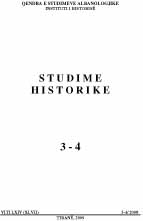Gjurmë të pranisë së hebrejve në Shqipëri gjatë Mesjetës
Traces of Jewish presence in Albania during Medieval Period
Author(s): Pëllumb XhufiSubject(s): History
Published by: Qendra e Studimeve Albanologjike
Keywords: Traces of Jewish presence ; Albania ; Medieval Period; Albania; Albanian History;
Summary/Abstract: The largest presence of Jewish community in Albania is testified in the XV-XVI century, and it is certainly related with the Sephardic Diaspora that brought here Jewish groups from Spain and Spanish Sicily (1492). The ottoman registry of the property and the population of Vlora of the year 1591 -1520 shows that only in Vlora city, in that period 528 were Jewish, besides 945 Christian and 85 Muslim families out of 1558 families. Other registers make us believe that Jewish population of Berati and Vlora was reduced in size; a part of the families re-emigrated toward other imperial centers, in Thessalonica and Ioannina. The conversion occurrence in Islam of many Jewish people is testified in this period, a process that has known a high moment during the activity in Berati area, during the years 1666-1676, of “false messiah, heterodox Jewish and later converted Sabatah Zevi. Jewish in Albania were present earlier than 16th century; at least since the end of the antique period, V-VI century, the epigraphic testimonies prove this fact. In the Byzantine period (VI-XIV century) in the coastal cities of Durres and Vlora it is always talked about individuals or Jewish communities, linked with trade (exercitium mercanties) and craftsmanship. It is worth mentioning the Jewish Community of Durres. This is testified in 1322 from English traveler Symeon Symeonis and it is confirmed by a document of 1417, evaluated from us for the first time where it is spoken for a special Jewish quarter of that city (Judaica Durachii). Jewish from Vlora and Durres kept preferential relations with the markets of Sicily and those of Venetian Republic. They exported special products as grains, silk or salt. The vendors exercised a kind of monopoly on salt, as sometimes they were obtruded even of the Angevine and Venetian governors, who attempted to have control over this profitable market. The relations between Jewish and the local population are good testified. There is a lack of some anti-Semite signs, as were common in that period in the Christian Europe. Therefore, when a citizen from Durrës had the courage to bit a Jewish woman, his punishment was horrible; indeed he was punished pulling out one eye. On the contrary in Vlora or Durrës there are some testimonies of solidary attitude of the locals versus the Jewish community. Thus in 1401, a representative group of Durrës citizens, officially required to the Venetian Senate to exclude from the special tax catasamiti the Jewish people of the city, According to them, the Venetian government did not have any profit form this special tax because “ Durrës Jewish were few and poor”. This was not true, Durrës Jewish were neither few nor poor. The fact that Jewish people are continually appearing as testimonies and guaranties in the contracts between other not Jewish citizens, shows for the Jewish treatment in Albanian cities.
Journal: Studime Historike
- Issue Year: 2008
- Issue No: 03-04
- Page Range: 007-018
- Page Count: 12
- Language: Albanian
- Content File-PDF

